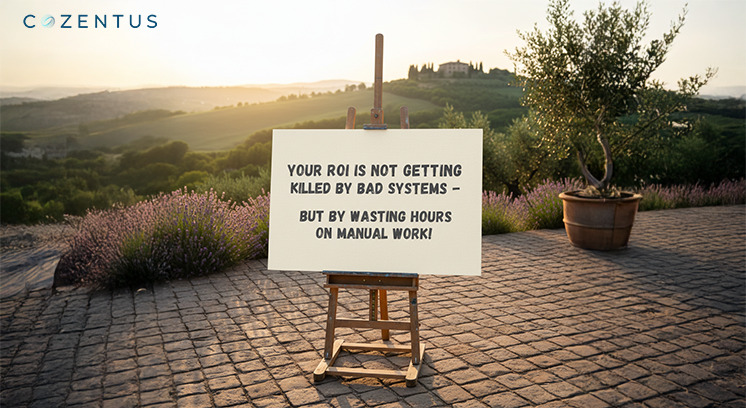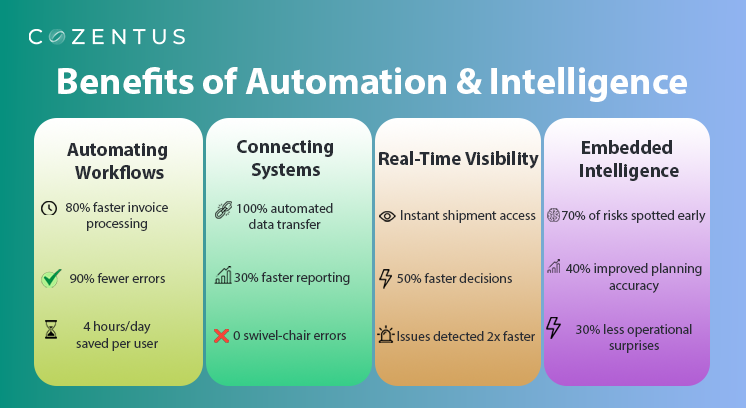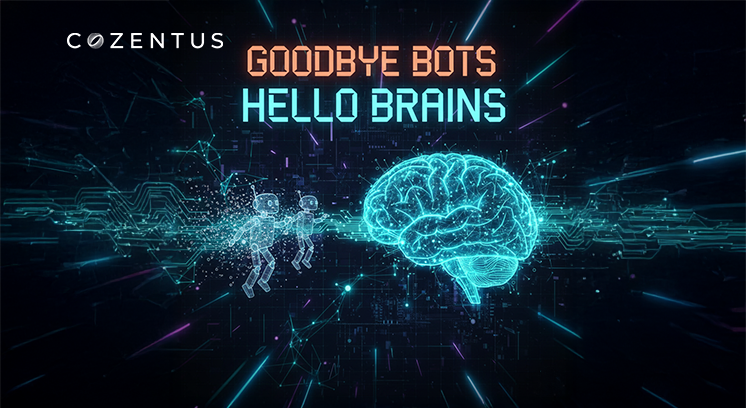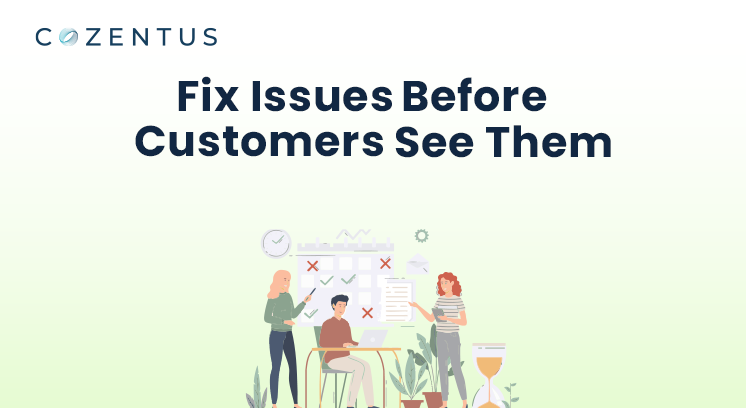The Real Bottleneck Isn’t Your System
Think about the last time your operations team handled a shipment exception. Chances are, they weren’t complaining about your Transportation Management System (TMS). Instead, they were jumping between email, spreadsheets, WhatsApp messages, and multiple portals - copying, pasting, and re-entering the same information.
This "swivel-chair" style of operations is where productivity gets lost, errors increase, and customers start calling. And while companies often blame their core systems (whether TMS, ERP, or WMS), the truth is, these platforms aren’t broken. What’s broken is the way teams work around them.
At Cozentus, we see this every day across industries. Leaders spend millions on robust platforms, but the real challenge is fragmented, manual processes sitting in between.
The good news? This can be fixed without replacing your TMS.
Let’s check how!

Why Swivel-Chair Ops Still Exists
Despite automation and digital investments, most operations teams continue to rely on manual data transfer. Why?
- Too many systems, not enough integration.
Your TMS is powerful, but it doesn’t always “talk” seamlessly with other systems. This includes ERP, WMS, partner portals, or BI dashboards.
- People filling the gaps.
Instead of automation, teams are often tasked with bridging the gap. They log in to one system, pull a report, paste it into Excel, and send it on. It works - but at a cost.
- Decision-making is slowed down.
When leaders don’t have a single version of the truth, they wait for reports, reconcile numbers, or make decisions with partial data.
- The myth of “system replacement.”
Many organizations assume that a new TMS will solve all their problems. But six months post-implementation, swivel-chair ops creeps back in. Because the issue isn’t the TMS - it’s the layer around it.
What It Costs Your Business
For senior leaders, swivel-chair ops may look like a small inefficiency. But in practice, the impact compounds across operations.
- Lost productivity: Teams spend hours every week just moving data around. That’s time not spent on problem-solving or customer engagement.
- Higher error rates: Manual transfers create missed updates and version mismatches.
- Slower response times: Customers don’t wait for your spreadsheets to be updated. They call, and the answer often isn’t ready.
- Hidden costs: Overtime, duplicate work, rework, and missed billing opportunities quietly erode margins.
- Frustration and turnover: Skilled staff don’t want to spend their day copying data. It drives disengagement.
For logistics, especially, where every delay ripples through supply chains, the cost of swivel-chair ops is even sharper. But the reality is, these pain points aren’t unique to logistics; they’re common across finance, operations, procurement, and shared services.
So, What’s the Fix?
The solution isn’t buying another massive platform. It’s about creating a layer of intelligence and automation around your existing systems.
At Cozentus, we help clients do exactly this by:
- Automating manual workflows. Tasks like invoice matching, status updates, or report generation can be handled by automation instead of people.
- Connecting systems seamlessly. Whether it’s TMS to ERP or WMS to BI dashboards, we remove the swivel chair by letting data flow where it needs to, automatically.
- Delivering real-time visibility. Instead of waiting for yesterday’s report, leaders get live dashboards showing what’s happening with their shipments right now.
- Embedding intelligence. Using AI and analytics, we don’t just move data faster—we make it meaningful. Leaders can spot risks, trends, and exceptions before they escalate.

Real Example: From Hours to Minutes
Consider a logistics operations team managing hundreds of daily shipments. Before, every delay required them to:
- Pull updates from carrier portals.
- Update spreadsheets.
- Email customers.
- The cycle repeated endlessly, eating up hours every day.
With automation and system integration, that same process now happens in minutes. Spreadsheets update themselves. Exceptions are flagged automatically. Customers receive proactive updates.
The result? Four hours a day freed up per person. This time is redirected toward improving service, negotiating rates, or optimizing routes.
Leaders Should Care About This
- Your growth is capped. Manual work doesn’t scale. As volumes grow, so does headcount - unless processes are fixed.
- Your decisions lag reality. If leadership visibility relies on end-of-week reporting, you’re already behind the market.
- Your customer experience suffers. Delays, errors, and inconsistent updates erode trust.
- Your transformation ROI shrinks. You’ve invested in TMS, ERP, WMS, BI - but if people are still stitching data together manually, the returns fall short.
Fixing swivel-chair ops means unlocking the full potential of your systems and your people.
How Business Intelligence is Involved
Business Intelligence (BI) isn’t just about dashboards. Done right, it’s about reducing the need for manual transfers and helping leaders make better decisions, faster.
- Unified view. BI pulls data from all systems into one version of the truth.
- Actionable insights. Not just what happened, but why, and what to do next.
- Warehouse and logistics visibility. From inventory positions to carrier performance, BI shines a light where it matters.
- Self-service decision-making. Leaders don’t need to wait for reports; they can explore data in real-time.
At Cozentus, we combine BI with automation, AI, and process re-engineering - so it’s not just data on a dashboard, but a complete shift away from swivel-chair ops.
You need to check this out: This 2-Week Fix Replaced Hours of Daily Ops Chaos
Why Cozentus?
We partner with global enterprises across industries to eliminate the friction around core systems. Our services cover:
- Process Automation: Taking manual, repetitive tasks off your team’s plate.
- AI & Analytics: Turning data into predictive, actionable insights.
- Real-Time Visibility: Enabling leaders to see operations as they happen.
- Risk Monitoring: Flagging exceptions, anomalies, and compliance issues early.
- Testing Services: Ensuring systems work seamlessly before and after deployment.
- Transformation Consulting: Designing future-ready operating models.
Instead of another rip-and-replace project, we help organizations maximize what they already own, and remove the swivel-chair ops that slow them down.
The Executive Takeaway
If your teams are spending hours moving data between systems, the problem isn’t your TMS. It’s the swivel-chair ops around it.
And here’s the opportunity: fixing it doesn’t require a massive new system. It requires a smarter layer -automation, BI, AI, and process redesign. This helps in freeing people, connecting systems, and delivering visibility.
The leaders who address swivel-chair ops don’t just save hours. They create an organization that:
- Scales without friction.
- Makes decisions in real time.
- Delivers a superior customer experience.
- Unlocks the full ROI from existing technology investments.
At Cozentus, we believe your systems aren’t the problem. The way work happens around them is. And that’s exactly where we help.
Closing Thought
The next time someone suggests replacing your TMS, pause. Ask instead:
- Where are my teams still copying data manually?
- How much time is lost in swivel-chair ops?
- What would my business gain if those hours were freed?
Chances are, the answer is worth far more than the cost of a new system. And with the right partner, it’s achievable today.
If you are losing precious hours doing manual work, call us now!
Recent Post
Subscribe to our newsletter
Stay updated on latest trends and news in the supply chain and logistics industry







